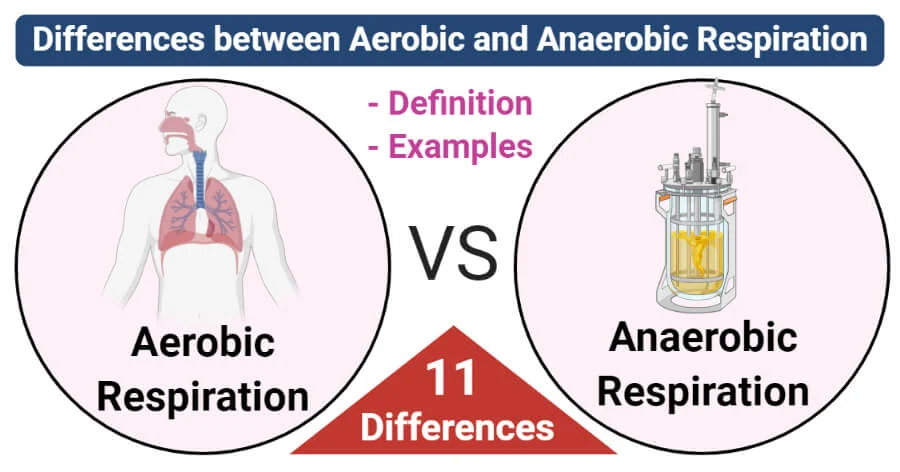What is the Difference Between Aerobic and Anaerobic Respiration?
Respiration is a fundamental biological process that provides energy for living organisms. It can be classified into two main types: aerobic respiration and anaerobic respiration. Understanding the differences between these two processes is essential for students of biology, health professionals, and anyone interested in how living organisms generate energy. This article will delve into the definitions, mechanisms, advantages, disadvantages, and examples of both aerobic and anaerobic respiration, along with a detailed FAQ section.
Definition of Aerobic and Anaerobic Respiration
Aerobic Respiration: This type of respiration occurs in the presence of oxygen. It is the process by which cells convert glucose and oxygen into energy, carbon dioxide, and water. Aerobic respiration is more efficient than anaerobic respiration, producing a higher yield of ATP (adenosine triphosphate), the energy currency of the cell.
Anaerobic Respiration: In contrast, anaerobic respiration occurs in the absence of oxygen. This process allows organisms to generate energy through the breakdown of glucose without using oxygen. Anaerobic respiration is less efficient than aerobic respiration, resulting in the production of fewer ATP molecules and different byproducts, such as lactic acid or ethanol.
Overview of the Respiration Process
Both aerobic and anaerobic respiration begin with the breakdown of glucose through a process called glycolysis. Glycolysis occurs in the cytoplasm of the cell and converts glucose into pyruvate, yielding a small amount of ATP. The subsequent steps differ based on the availability of oxygen.
Aerobic Respiration Process
- Glycolysis: Glucose is broken down into pyruvate, producing a net gain of 2 ATP molecules.
- Krebs Cycle: In the presence of oxygen, pyruvate enters the mitochondria and undergoes the Krebs cycle (also known as the citric acid cycle), generating electron carriers (NADH and FADH2) and releasing carbon dioxide.
- Electron Transport Chain (ETC): The electron carriers produced in the Krebs cycle donate electrons to the ETC, where ATP is synthesized through oxidative phosphorylation. Water is produced as a byproduct when electrons combine with oxygen.
The overall equation for aerobic respiration can be summarized as follows:Glucose+Oxygen→Carbon Dioxide+Water+Energy ATP
Anaerobic Respiration Process
- Glycolysis: Similar to aerobic respiration, glucose is broken down into pyruvate, yielding 2 ATP.
- Fermentation: In the absence of oxygen, pyruvate undergoes fermentation. The type of fermentation depends on the organism:
- Lactic Acid Fermentation: Occurs in animal cells (e.g., muscle cells) and some bacteria. Pyruvate is converted into lactic acid.
- Alcoholic Fermentation: Occurs in yeast and some bacteria. Pyruvate is converted into ethanol and carbon dioxide.
The overall equations for anaerobic respiration can be summarized as follows:
- Lactic Acid Fermentation:
Glucose→Lactic Acid+Energy ATP - Alcoholic Fermentation:
Glucose→Ethanol+Carbon Dioxide+Energy ATP
Comparison of Aerobic and Anaerobic Respiration
| Feature | Aerobic Respiration | Anaerobic Respiration |
|---|---|---|
| Oxygen Requirement | Requires oxygen | Does not require oxygen |
| Location | Occurs in mitochondria | Occurs in the cytoplasm |
| ATP Yield | Produces 36-38 ATP molecules per glucose | Produces 2 ATP molecules per glucose |
| End Products | Carbon dioxide and water | Lactic acid (in animals) or ethanol and carbon dioxide (in yeast) |
| Organisms | Most plants and animals | Some bacteria, yeast, and muscle cells during intense exercise |
| Efficiency | More efficient (higher energy yield) | Less efficient (lower energy yield) |
Advantages and Disadvantages
Aerobic Respiration
Advantages:
- Higher ATP yield provides more energy for cellular functions.
- Produces less toxic byproducts (carbon dioxide and water).
- Supports larger and more complex organisms due to efficient energy production.
Disadvantages:
- Requires a constant supply of oxygen, limiting survival in anaerobic environments.
- Slower process compared to anaerobic respiration.
Anaerobic Respiration
Advantages:
- Can occur in environments lacking oxygen, allowing survival in diverse habitats.
- Faster energy production, which can be beneficial during short bursts of intense activity.
Disadvantages:
- Lower ATP yield results in less energy available for cellular processes.
- Produces toxic byproducts (lactic acid or ethanol) that can accumulate and cause cellular damage.
Examples of Aerobic and Anaerobic Respiration in Organisms
- Aerobic Respiration:
- Humans: Utilize aerobic respiration during rest and moderate activities, relying on oxygen to produce energy.
- Plants: Perform aerobic respiration continuously, using oxygen produced during photosynthesis.
- Anaerobic Respiration:
- Yeast: Undergo alcoholic fermentation, producing ethanol and carbon dioxide, which is utilized in brewing and baking.
- Muscle Cells: During intense exercise, muscle cells switch to anaerobic respiration, producing lactic acid when oxygen levels are insufficient.
Conclusion
Understanding the differences between aerobic and anaerobic respiration is crucial for comprehending how organisms generate energy. While aerobic respiration is more efficient and produces less toxic byproducts, anaerobic respiration allows organisms to survive in low-oxygen environments and provides quick energy during intense activities. Both processes play vital roles in the energy metabolism of living organisms.
FAQ
Q1: What is the main difference between aerobic and anaerobic respiration?
A1: The main difference is that aerobic respiration requires oxygen, while anaerobic respiration occurs in the absence of oxygen.
A2: Aerobic respiration produces more ATP (36-38 ATP molecules) compared to anaerobic respiration (2 ATP molecules).
A3: The byproducts of anaerobic respiration can be lactic acid (in animals) or ethanol and carbon dioxide (in yeast).
A4: Yes, humans can perform anaerobic respiration, particularly during intense exercise when oxygen levels are low, resulting in lactic acid production.
A5: Aerobic respiration occurs in the mitochondria of eukaryotic cells.
References
- Wikipedia – Aerobic and Anaerobic Respiration



